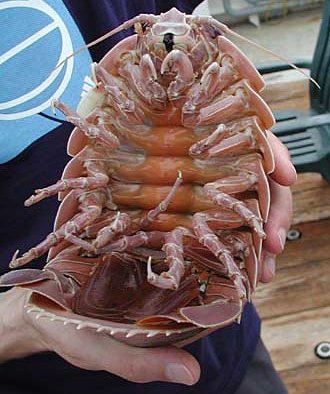
Note: Real world giant isopods inhabit certain locations in the deep ocean, but I don't see why we oughtn't have species in dungeons and dank old woodlands in game. Isopods are incredibly adaptable with some astonishing abilities allowing them to colonise so many habitats around the world, and they figure in the folklore of so many peoples as is shown by the multiplicity of names these hoglouse, chucky pigs, slaters and, indeed, doodlebugs have gained.
Doodlebug
by Cab Davidson
| Doodlebug | Stat |
| AC: | 3 |
| HD: | 1/2 |
| Movement: | 90'(30') |
| Attacks: | 1 bite |
| Damage: | 1d3 |
| No. Appearing: | 2d6 (6d6) |
| Save As: | NM |
| Morale: | 8 |
| Treasure Type: | U |
| Intelligence: | 0 |
| Alignment: | Neutral |
| XP Value: | 5 |
There are many species of giant isopods, essentially woodlice growing up to a foot and a half long, found in the depths of ancient woodlands, dank dungeons and in the bottom of the oceans. And while they vary somewhat in colour from ghostly pale white to dark slate black, via. mottled brown and dark beige, they all fill a similar role of eating the hard to digest matter other creatures cannot access. Giant isopods are truly omnivorous, scavenging from anything dead that they can find, able (often by ingesting, excreting, and eating again) nearly anything.
Doodlebugs are low to the ground and incredibly stable – they can clink to the substrate in fast flowing water or strong wind and can neither be tripped or hooked. While, owing to their size, they cannot climb sheer surfaces or ceilings, they can navigate steep terrain and climb surprisingly well.
It is rare that they attack live prey, but incapacitated or slowed opponents can be taken if a doodlebug (the name given to them by deeper dwelling gnomes, who are occasionally known to hunt them for food) can be targeted.